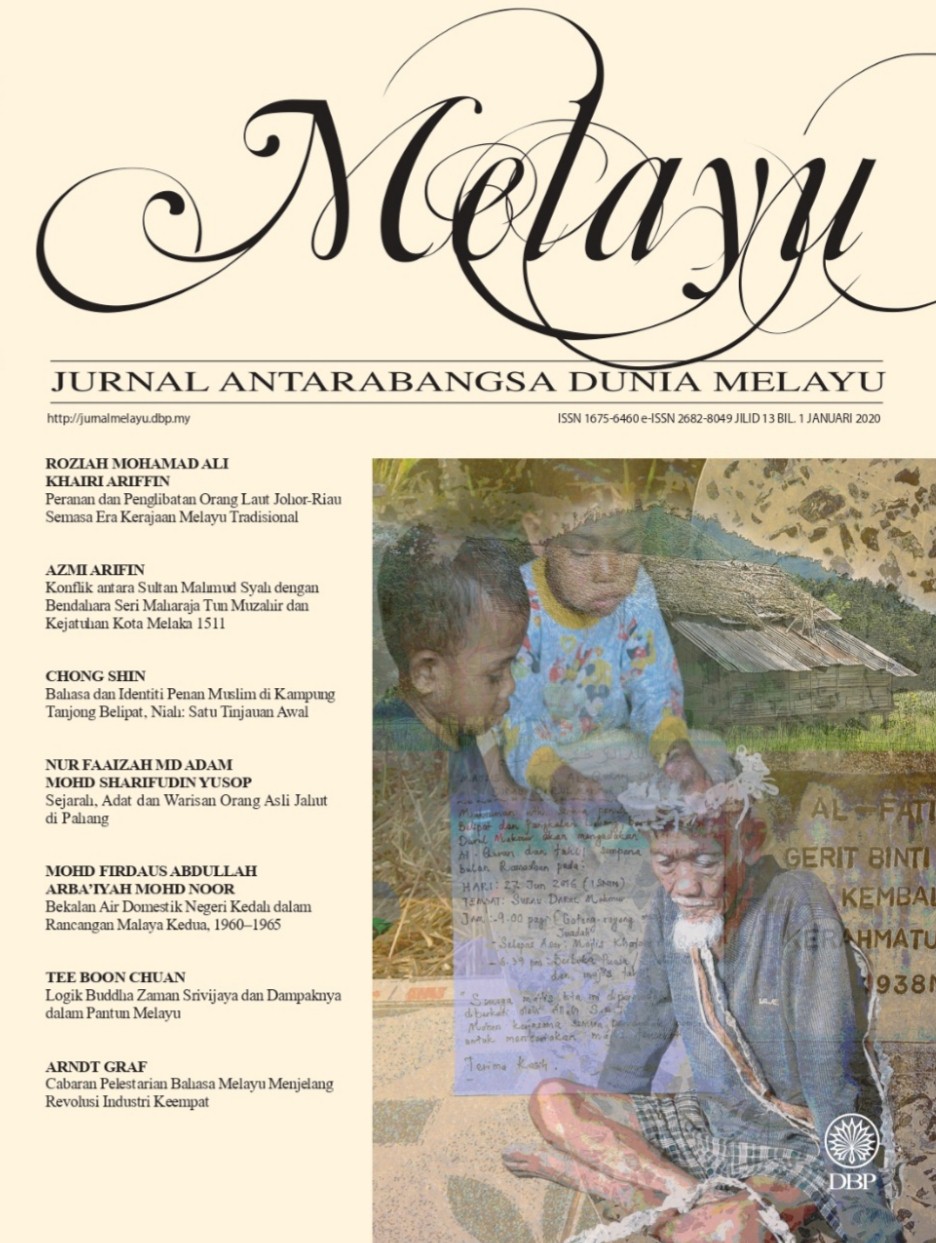The Language and Identity of the Penan Muslims in KampongTanjong Belipat, Niah: A Preliminary Study
(Bahasa dan Identiti Penan Muslim di Kampung Tanjong Belipat, Niah: Satu Tinjauan Awal)
Abstract
This article discusses the Penan Muslim community, which lives scattered around the Niah and Suai river valley in the northern part of Sarawak. In the past, they were a nomadic tribe that settled the remote areas in Sarawak and Kalimantan. Since the 19th century, some moved to the coastal area and embraced Islam as the religion of their community. The Penan Muslims in Tanjong Belipat village are one such community. After converting to Islam, the Penan Muslims abandoned their old traditional beliefs and also their mother tongue, the Penan language. Linguistically, the Penan language belongs to the Kayan-Kenyah language subgroup. After they embraced Islam, they adopted the Bintulu language-another language from the subgroup of languages in Northern Sarawak-as their main language. The Penan and Bintulu languages are mutually unintelligible. This kind of inter-group language shifting has a relation to religion, i.e. the Penan chose a language which they felt symbolizes a Muslim identity. Since the Bintulu tribe was the only Muslim tribe in the Niah valley, their language was chosen by the Penan as they adopted a new ethnic identity. After converting to Islam, the Penan Muslim community seems to have faced two complex yet subjective identities. Although they were now Muslim, they did not identify themselves as "Malay" like the Melanaus of Sarawak or the Dayak Muslims of Kalimantan. The term "Malay" was only used in certain circumstances and domains that are related to the economy. It is also observed that although the Penan Muslims are loyal to the Penan identity, intermarriage between them and the Malays has accelerated the "masuk Melayu" (becoming Malay) phenomenon among the Penan Muslim community.
Keywords: Penan, Penan Muslims, Islam, language, identity, becoming Melayu
References
Soriente, A. 2013. Undergoer Voices in Borneo: Penan, Punan, Kayan and Kenyah Languages. Dlm. K.A. Adelaar, (Ed.). Voice variation in Austronesian languages of Indonesia, hlm. 175-203. Jakarta: NUSA.
Babcock, T.G. 1974. Indigenous ethnicity in Sarawak. Sarawak Museum Journal. XXII(43): 191-202.
Bibi Aminah Abdul Ghani, Terry Justin Dit & Mawi Taip. 2009. People of the forest: The Penan. Kuching: Pustaka Negeri Sarawak.
Enthoven, J.J.K. 1903. Bijdragen tot de geographie van Borneo's Wester-Afdeeling Part 1. Leiden: Brill.
Faisal S. Hazis. 2008. Contesting Sarawak Malayness: Glimpses of the life and identity of the Malays in southwest Sarawak. Dlm. Zawawi Ibrahim (ed.). Representation, identity and multiculturalism in Sarawak, hlm. 263-296. Kuching & Kajang: Dayak Cultural Foundation & Persatuan Sains Sosial Malaysia.
Jehom, J.W. 1999. Ethnicity and ethnic identity in Sarawak. Akademika. 55: 83-98.
Jimmy Ibrahim. 1971. Dua ratus tahun kota Pontianak. Pontianak: Pemda Kotamadya Pontianak.
Kaboy, Tuton. 1974. The Penan Aput. Sarawak Museum Journal. XXII(43): 287-293.
King, V. 1993. The peoples of Borneo. Oxford: Blackwell Publishers. Langub, J. 1975. Distributions of Penan and Punan in the Belaga District. Borneo Research Bulletin 7(2): 45-48.
Langub, J. 1989. Some aspects of life od the Penan. Sarawak Museum Journal. XL(61):169-184.
Mohammed Azlan Mis, 2010. Lingua Franca Di Sarawak: Aplikasi Teori Pilihan Bahasa. Gema Online Journal. 10 (2): 97-116.
Morris, H. S. 1978. The Coastal Melanau. Dlm. King, V. T. (ed.). Essays on Borneo Societies, hlm. 37-58. Oxford: Oxford University Press.
Needham, R. 1955. Punan Ba. Journal of the Malayan Branch of the Royal Asiatic Society. 28(19): 24-36.
Needham, R. 1953. Penan and Punan. Journal of the Malayan Branch of the Royal Asiatic Society. 27(165): 73-83.
Needham, R. 2007. Penan. Dlm.
Pabali H. Musa. 2003. Sejarah kesultanan Sambas Kalimantan Barat. Kajian naskhah asal rajaraja dan silsilah Raja Sambas. Pontianak: STAIN: STAIN Press.
Shamsul A. B. 1999. Identity contestation in Malaysia: A comparative commentary on "Malayness" and "Chiness". Akademika. 55: 17-39.
Tischler, H.L. & Berry, B. 1978. Race and ethnic relations. Chicago: Houghton Mifflion Company.
Year Book of Statistics Sarawak, 2015. Jabatan Perangkaan Sarawak.
Yekti Mauriati. 2004. Identitas Dayak: Komodifikasi & politik Kebudayaan. Yogyakarta: LKiS Yogyakarta.
Yusriadi & Hermansyah. 2003. Orang Embau: Potret masyarakat pedalaman Kalimantan Barat. Pontianak: STAIN Press.
Yusriadi. 2005. Bahasa dan identiti di Riam Panjang. Disertasi Ph.D. Universiti Kebangsaan Malaysia.
Zainuddin Isman. 2001. Orang Melayu di Kalimantan Barat, kajian perubahan budaya pada komuniti pesisir dan komuniti pedalaman. Tesis Sarjana. Universiti Kebangsaan Malaysia.








